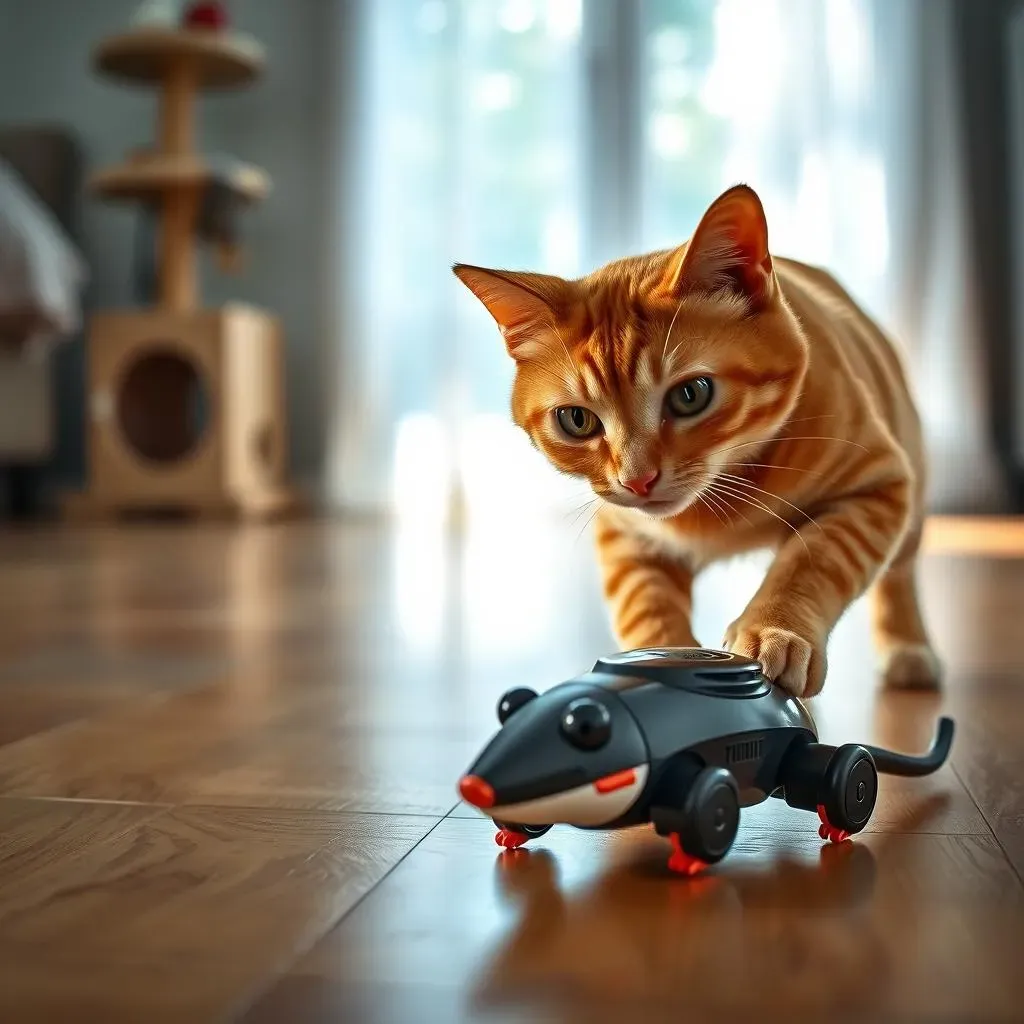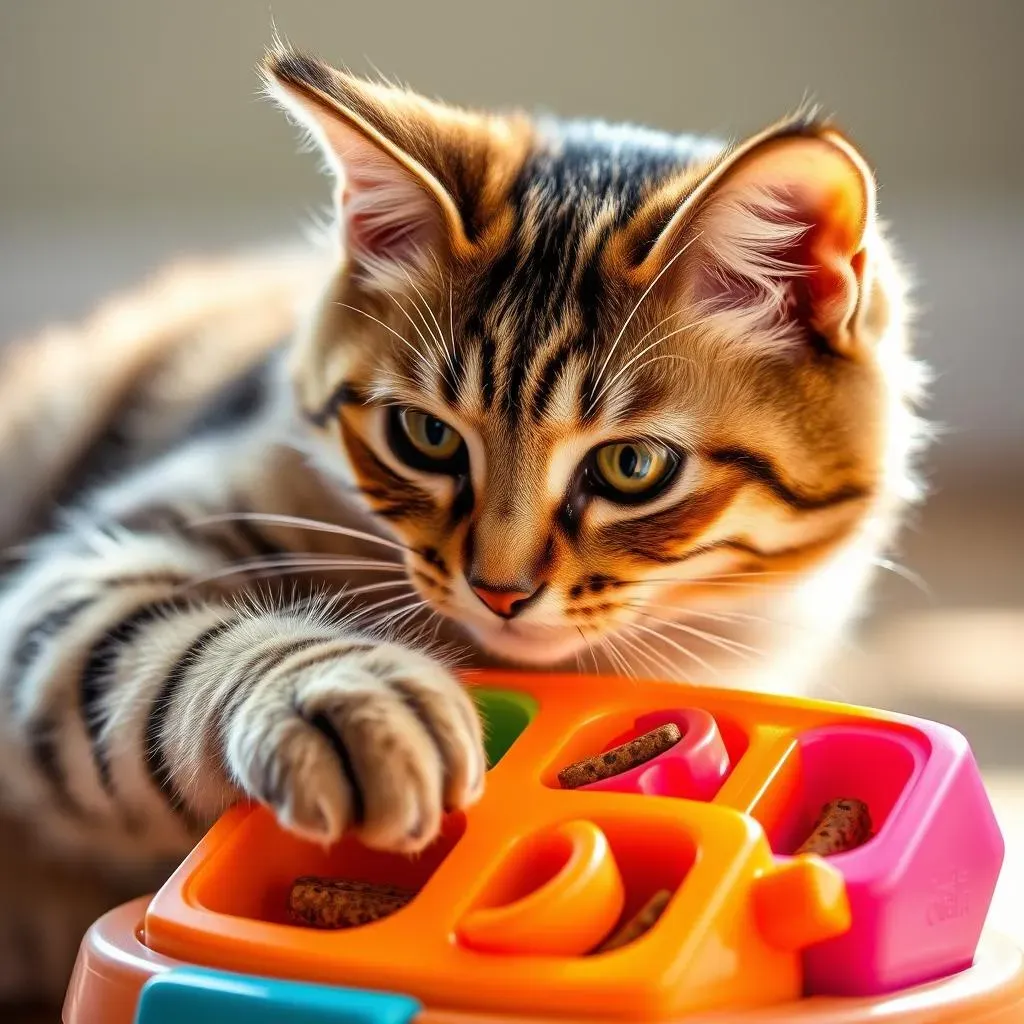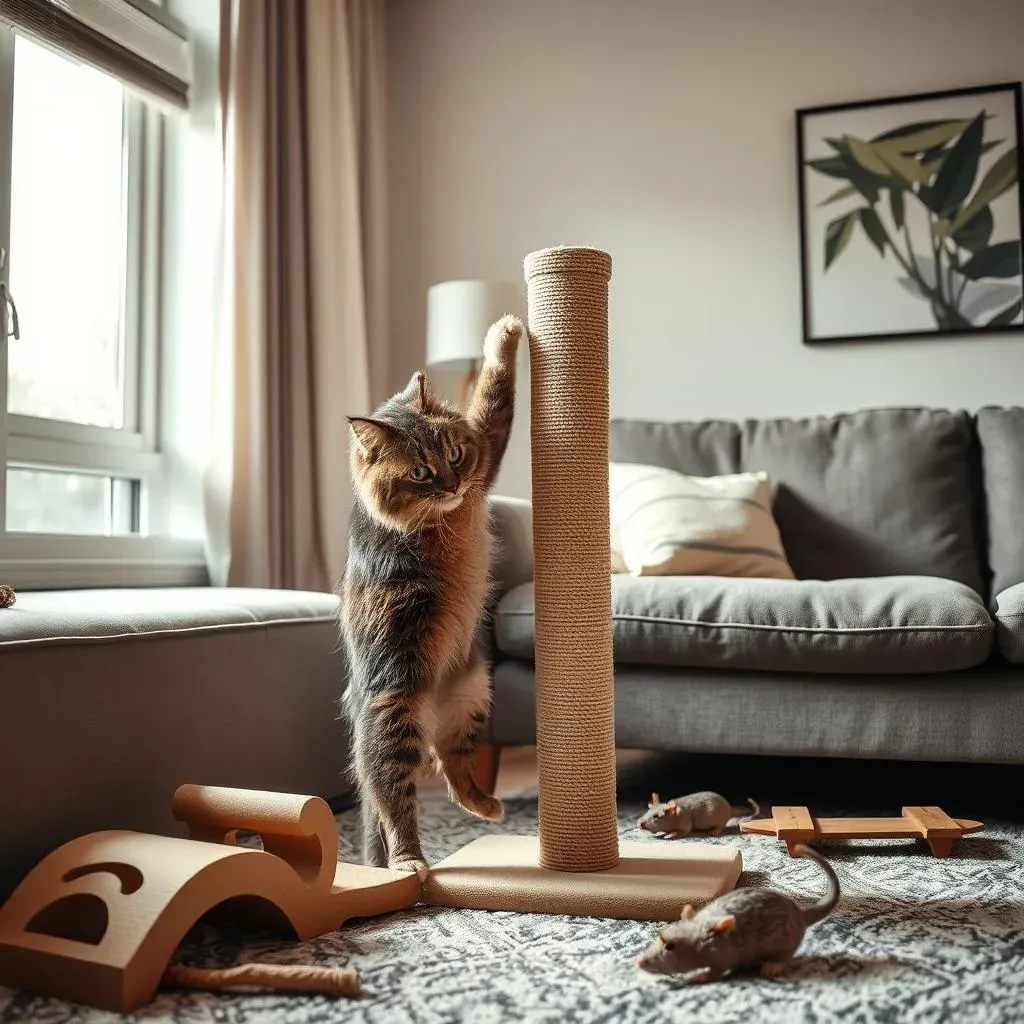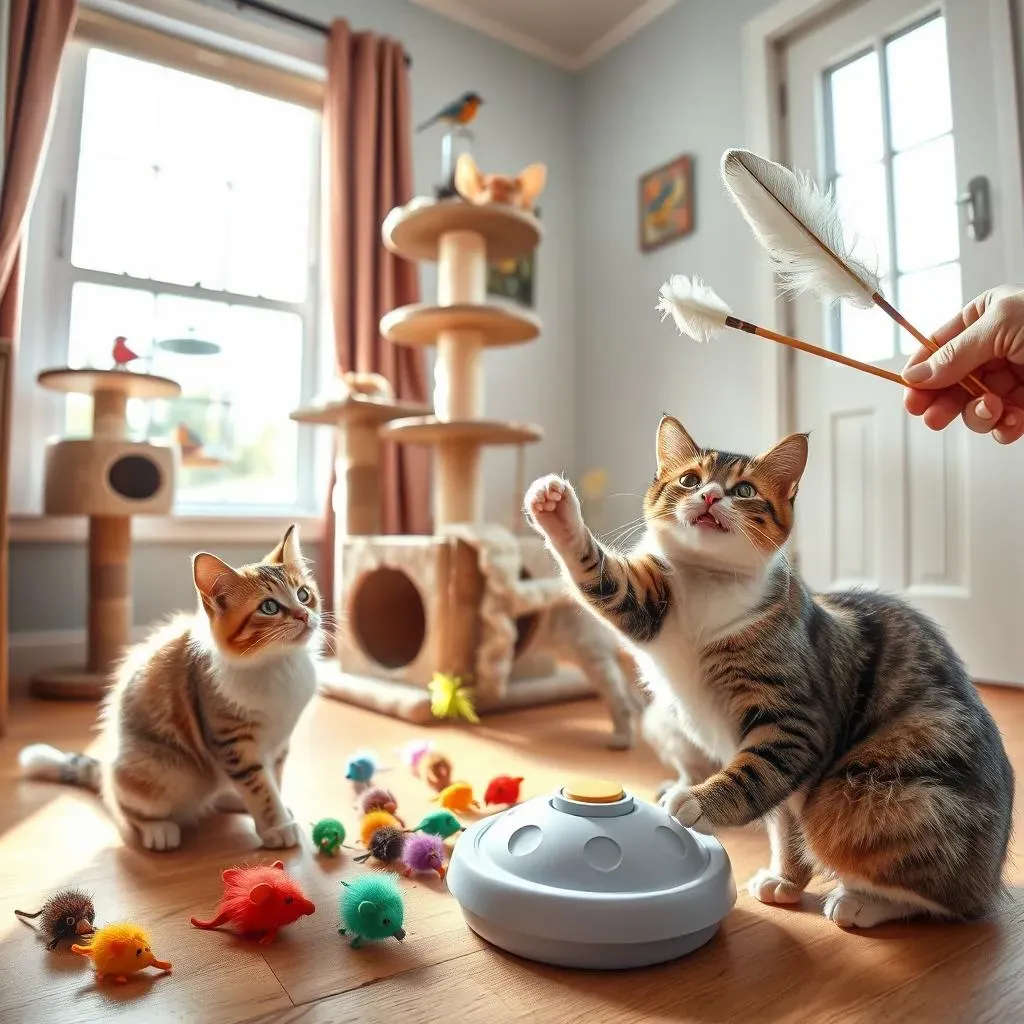Table of Contents
Leaving your feline friend at home alone can be tough. You worry: Are they bored? Lonely? Or plotting the demise of your favorite sofa? The truth is, cats need stimulation, even when you're not around. That's where the best cat toys for when you're gone come in. This isn't just about preventing boredom; it's about enriching their lives and ensuring their well-being. In this guide, we'll explore a curated selection of toys designed to keep your cat entertained, engaged, and out of trouble while you're away. We'll delve into interactive toys that mimic hunting, puzzle toys that challenge their minds, and scratching solutions that save your furniture. Plus, we'll discuss how to create a safe and stimulating environment that caters to your cat's unique needs. So, if you're ready to transform your cat's solo time from "meh" to "meow-velous," let's dive in and discover the purr-fect toys for your beloved companion.
Why Your Cat Needs Toys When You're Away

Why Your Cat Needs Toys When You're Away
Combating Boredom and Loneliness
Think about it: cats sleep a lot, but when they're awake, they're wired to hunt, explore, and play. Leaving them alone for hours without any outlet for these instincts is like asking a marathon runner to sit still all day – it's just not natural. Toys provide that crucial stimulation, keeping boredom at bay and preventing destructive behaviors that often stem from pent-up energy. Without toys, your cat might turn to your furniture, curtains, or even your ankles as alternative targets for their playful aggression. And let's be honest, nobody wants that!
More than just preventing mischief, toys combat loneliness. While cats are often portrayed as solitary creatures, they still crave interaction and engagement. A good toy can act as a surrogate playmate, offering a sense of comfort and security in your absence. It’s about keeping their minds active and their spirits high, even when they're flying solo.
The Physical and Mental Benefits
It's not just about fun and games; toys play a vital role in your cat's physical and mental well-being. Interactive toys encourage movement, helping to maintain a healthy weight and prevent obesity-related health issues. Chasing, pouncing, and batting at toys provide essential exercise, keeping their muscles toned and their cardiovascular system in tip-top shape. A cat that plays is a cat that stays healthier, longer.
Beyond the physical, toys stimulate their minds. Puzzle toys, for instance, challenge your cat to problem-solve and strategize, keeping their cognitive skills sharp. This mental stimulation is crucial for preventing cognitive decline as they age, ensuring they remain alert and engaged well into their golden years. It's like giving their brain a workout – a fun and rewarding one!
Satisfying Natural Instincts
Cats are born hunters. It's in their DNA. Toys provide a safe and appropriate way for them to express these natural instincts, even indoors. Toys that mimic prey, like feather wands or plush mice, allow them to stalk, chase, and capture, satisfying their innate desire to hunt. Scratching posts and toys, on the other hand, fulfill their need to groom their claws and mark their territory, preventing them from using your furniture as a substitute.
By providing toys that cater to these instincts, you're not just entertaining your cat; you're fulfilling a fundamental part of their being. It's about creating an environment where they can be their authentic selves, even when you're not there to supervise. And a happy, fulfilled cat is a well-behaved cat, making your life easier and more enjoyable too.
Examples of instinct-satisfying toys:
- Feather wands for hunting
- Plush mice for capturing
- Scratching posts for grooming claws
The Best Interactive Cat Toys for Solo Play

The Best Interactive Cat Toys for Solo Play
Motion-Activated Toys: Keeping Them on Their Paws
These toys are game-changers. Imagine a toy that springs to life when your cat gets close, mimicking the unpredictable movements of prey. We're talking about things like robotic mice that dart around, battery-operated butterflies that flutter enticingly, and even balls that roll and change direction on their own. The key here is unpredictability. A toy that does the same thing every time will quickly lose its appeal. But one that keeps your cat guessing? That's a recipe for hours of solo entertainment.
The beauty of motion-activated toys is that they tap into your cat's natural hunting instincts without requiring your direct involvement. They encourage your cat to stalk, chase, and pounce, providing both physical exercise and mental stimulation. Plus, many of these toys come with adjustable settings, allowing you to customize the level of activity to suit your cat's personality and energy levels. Is your cat a lazy lounger? Start with a slow, gentle setting. A high-energy hunter? Crank it up and watch them go!
Here's a quick rundown of popular motion-activated options:
- Robotic Mice: Classic chase toys that mimic the movement of real rodents.
- Interactive Balls: Rolling balls with lights, feathers, or catnip to entice play.
- Fluttering Butterflies: Battery-operated butterflies that mimic the flight of insects.
Toys with Random Movement Patterns
Similar to motion-activated toys, these toys have the added benefit of unpredictable movement patterns. Instead of just moving in a straight line or following a predictable path, these toys change direction randomly, making them even more engaging for your cat. Think of it like this: a laser pointer is fun for a few minutes, but a laser pointer that bounces off the walls and changes direction unexpectedly is a whole new level of entertainment. The same principle applies here.
Many of these toys use internal timers or sensors to vary their movements, keeping your cat guessing and preventing them from becoming bored. Some even come with different play modes, allowing you to switch things up and keep your cat on their toes. Plus, the element of surprise encourages your cat to stay alert and focused, providing a mental workout as well as a physical one.
Consider these options for unpredictable fun:
Toy Type | Description | Benefits |
|---|---|---|
Wobbling Toys | Toys with a weighted base that wobble and rock unpredictably. | Encourages chasing and batting, provides a good physical workout. |
Automatic Laser Pointers | Laser pointers that move randomly across the floor and walls. | Stimulates hunting instincts, provides mental stimulation. |
Interactive Treat Dispensers | Toys that release treats randomly as your cat plays with them. | Combines play with a reward, keeps cats engaged for longer periods. |
Toys with Built-in Timers
Sometimes, the best way to keep your cat interested is to limit their access to the toy. That's where toys with built-in timers come in. These toys are designed to turn on and off automatically at pre-set intervals, creating a sense of anticipation and preventing your cat from becoming desensitized to the toy. Imagine a toy that turns on for 15 minutes every few hours, providing a burst of excitement throughout the day. It's like a little surprise party for your cat, keeping them entertained even when you're not there to play.
The key is to choose toys with timers that can be customized to suit your cat's individual needs and preferences. Some cats prefer shorter, more frequent play sessions, while others prefer longer, less frequent ones. Experiment with different settings to find what works best for your feline friend. And don't be afraid to rotate different toys with timers to keep things fresh and exciting. A little variety can go a long way in preventing boredom and keeping your cat happy and engaged.
Remember, the goal is to provide entertainment and stimulation, not to create frustration or anxiety. Always supervise your cat's playtime with new toys to ensure they are safe and appropriate. And if you notice any signs of stress or discomfort, remove the toy and try something else. After all, a happy cat is a healthy cat!
Puzzle Toys: Engaging Your Cat's Mind While You're Out

Puzzle Toys: Engaging Your Cat's Mind While You're Out
The Benefits of Mental Stimulation
let's talk puzzle toys! These aren't just about keeping your cat busy; they're about giving their brains a serious workout. Think of it as cross-training for their minds. A bored cat is often a destructive cat, but a mentally stimulated cat? Now, that's a happy, well-adjusted feline. Puzzle toys tap into their natural problem-solving abilities, encouraging them to think, strategize, and work for their reward – usually a tasty treat. It's like giving them a mini-mission to accomplish while you're away, keeping them engaged and preventing boredom from setting in.
But the benefits go beyond just preventing mischief. Mental stimulation is crucial for cognitive health, especially as cats age. Just like humans, cats can experience cognitive decline as they get older, leading to confusion, disorientation, and changes in behavior. Puzzle toys help to keep their minds sharp and active, potentially slowing down the aging process and ensuring they remain alert and engaged well into their senior years. It's an investment in their long-term well-being, disguised as a fun and rewarding game.
Types of Puzzle Toys
Now, let's get down to the nitty-gritty: what kinds of puzzle toys are out there? The good news is, there's a puzzle toy for every cat, regardless of their personality or skill level. Some toys are simple, requiring your cat to bat or nudge a component to release a treat. Others are more complex, involving multiple steps and requiring them to use their paws, noses, and even their tongues to solve the puzzle. The key is to start with something easy and gradually increase the difficulty as your cat becomes more proficient.
One popular option is treat-dispensing balls. These balls have holes or compartments that release treats as your cat rolls them around. They're great for encouraging exercise and providing a sense of reward. Another option is puzzle feeders, which require your cat to manipulate different components to access their food. These are perfect for slowing down fast eaters and providing mental stimulation during mealtime. And then there are interactive puzzles, which involve sliding panels, rotating discs, or lifting cups to reveal hidden treats. These are ideal for cats who enjoy a challenge and are looking for a more complex mental workout.
Here's a breakdown of common puzzle toy types:
Toy Type | Description | Difficulty Level | Benefits |
|---|---|---|---|
Treat Balls | Balls with holes that release treats as they roll. | Easy | Encourages exercise, provides reward. |
Puzzle Feeders | Dishes with compartments that require manipulation to access food. | Medium | Slows down eating, provides mental stimulation. |
Interactive Puzzles | Puzzles with sliding panels, rotating discs, or lifting cups. | Hard | Provides a complex mental workout, challenges problem-solving skills. |
Scratching Posts and Toys: Protecting Your Furniture and Satisfying Your Cat's Instincts

Scratching Posts and Toys: Protecting Your Furniture and Satisfying Your Cat's Instincts
Why Cats Scratch: It's More Than Just Sharpening Claws
Let's face it, one of the biggest concerns for cat owners is furniture damage. But scratching isn't just about your cat being a jerk; it's a deeply ingrained instinct. Cats scratch to sharpen their claws, remove dead outer layers, and stretch their muscles. More importantly, scratching is a way for them to mark their territory, both visually (those scratch marks) and chemically (they have scent glands in their paws). So, when your cat scratches your couch, they're essentially saying, "This is mine!" Providing appropriate scratching outlets is crucial for redirecting this natural behavior away from your beloved belongings.
Think of it this way: you wouldn't expect a dog not to bark, would you? Scratching is just as natural for cats. The key is to offer them a more appealing alternative to your furniture. And that's where scratching posts and toys come in. By providing a variety of scratching surfaces, you're giving your cat a choice and empowering them to express their instincts in a way that doesn't destroy your home. It's a win-win situation!
Types of Scratching Posts and Toys
Now, let's talk options! Scratching posts come in all shapes, sizes, and materials, so it's important to find one that appeals to your cat's individual preferences. Some cats prefer vertical posts, while others prefer horizontal scratchers. Some like carpet, while others prefer sisal, cardboard, or even wood. The key is to experiment and see what your cat gravitates towards. Consider the size and stability of the post as well. It should be tall enough for your cat to fully stretch out and sturdy enough not to topple over when they really get into it.
In addition to traditional scratching posts, there are also a variety of scratching toys available. These can range from simple cardboard scratchers to more elaborate interactive toys with built-in scratching surfaces. Some scratching toys even incorporate catnip to further entice your cat. The great thing about scratching toys is that they provide both physical and mental stimulation, keeping your cat entertained and engaged while also satisfying their scratching needs.
Here's a handy guide to different scratching options:
Scratching Option | Description | Pros | Cons |
|---|---|---|---|
Vertical Posts | Tall posts covered in carpet, sisal, or wood. | Allows for full-body stretch, mimics tree scratching. | Can take up more space, may not appeal to all cats. |
Horizontal Scratchers | Flat scratchers made of cardboard, carpet, or sisal. | Takes up less space, appeals to cats who prefer scratching on the ground. | May not provide as much of a stretch, can be less durable. |
Scratching Toys | Toys with built-in scratching surfaces, often incorporating catnip. | Provides both physical and mental stimulation, portable. | May not be as durable as dedicated scratching posts, can be smaller. |
Placement and Encouragement: Getting Your Cat to Scratch the Right Thing
you've got the perfect scratching post, but how do you convince your cat to use it? Placement is key! Observe where your cat likes to scratch and place the post nearby. If they're scratching the corner of your couch, put the post right next to it. You can also try using catnip to entice them to investigate the post. Sprinkle a little catnip on the scratching surface to make it more appealing. Another trick is to use a toy to encourage them to interact with the post. Drag a feather wand or laser pointer across the surface to get them to chase and scratch.
Positive reinforcement is also crucial. Whenever you see your cat using the scratching post, praise them and give them a treat. This will help them associate the post with positive experiences and make them more likely to use it in the future. And whatever you do, avoid punishing your cat for scratching your furniture. This will only create fear and anxiety and won't solve the underlying problem. Instead, focus on providing them with appealing alternatives and rewarding them for using those alternatives.
Remember, it may take some time and patience to redirect your cat's scratching behavior. But with the right tools and techniques, you can protect your furniture and satisfy your cat's natural instincts. It's all about understanding their needs and providing them with a scratching outlet that they find irresistible.
Creating a Safe and Fun Environment with the Best Cat Toys

Creating a Safe and Fun Environment with the Best Cat Toys
Choosing Safe Materials and Avoiding Hazards
so you've got a mountain of awesome toys, but are they safe? This is HUGE. Cats explore the world with their mouths, so avoid anything with small parts that can be chewed off and swallowed – think bells, ribbons, or plastic eyes. Opt for toys made from durable, non-toxic materials like natural rubber, cotton, or felt. And always inspect toys regularly for wear and tear, tossing them out as soon as they start to fall apart. Trust me, a few bucks spent on safe toys is way better than a vet bill for a blockage.
Also, be mindful of strings and elastic. While cats love to play with these, they can be incredibly dangerous if ingested, potentially causing intestinal blockages. If you do offer toys with strings, make sure they're short and securely attached. And never leave your cat unsupervised with toys that have long strings or elastic bands. It's better to be safe than sorry!
Rotating Toys to Keep Things Fresh
Even the most amazing toy will lose its appeal if your cat has constant access to it. That's why toy rotation is key. Think of it like this: you wouldn't want to eat the same meal every day, would you? Cats are the same way. By rotating their toys, you're keeping things fresh and exciting, preventing boredom from setting in. A good rule of thumb is to keep a few toys out at a time and then swap them out every few days or weeks. This will make each toy feel new and exciting again, keeping your cat engaged and entertained.
You can also try storing the toys in a container with catnip to give them an extra boost of appeal. And don't be afraid to get creative with your rotation. Try hiding toys in different locations around the house or introducing a new toy that your cat has never seen before. The element of surprise can work wonders in keeping your cat interested and preventing them from becoming bored.
Here's a sample toy rotation schedule:
Week | Toys | Notes |
|---|---|---|
Week 1 | Motion-activated mouse, puzzle feeder, scratching post | Focus on hunting and mental stimulation. |
Week 2 | Interactive ball, treat ball, horizontal scratcher | Emphasize exercise and reward. |
Week 3 | Feather wand (supervised play), catnip mouse, vertical post | Encourage bonding and scratching. |
Week 4 | Introduce a new toy, rotate remaining toys | Keep things fresh and exciting. |
Creating a Stimulating Environment Beyond Toys
Toys are great, but they're just one piece of the puzzle. Creating a stimulating environment involves more than just providing playthings. Think about vertical space! Cats love to climb and perch, so provide them with cat trees, shelves, or window perches where they can survey their kingdom. A window with a view is like cat TV – endless entertainment! Also, consider adding hiding places where they can retreat and feel safe, like cardboard boxes, cat caves, or even just a cozy blanket in a quiet corner.
Don't underestimate the power of environmental enrichment. Simple things like bird feeders outside the window, the sound of nature playing on a speaker, or even just rearranging the furniture can make a big difference in your cat's overall well-being. The goal is to create an environment that caters to their natural instincts and provides them with opportunities to explore, play, and feel safe and secure. A happy cat is a cat that feels stimulated, both mentally and physically. And a stimulated cat is less likely to be bored, destructive, or anxious when you're not around. So, take a look around your home and see how you can create a more enriching environment for your feline friend. They'll thank you for it!
Ensuring a Happy, Enriched Life for Your Cat, Even When You're Away
Choosing the best cat toys for when you're gone isn't just about filling time; it's about providing enrichment, stimulation, and a sense of security for your feline companion. By understanding your cat's individual preferences and incorporating a variety of toys and activities, you can create a home environment that keeps them happy, engaged, and out of mischief, even in your absence. Ultimately, a well-stimulated cat is a happier, healthier cat, leading to a stronger bond between you and your beloved pet. So go ahead, invest in their happiness – they're worth it!